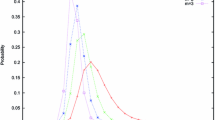Abstract
Joint distributions of the numbers of failures, successes andsuccess-runs of length less than k until the first consecutive k successesin a binary sequence were derived recently by Aki and Hirano (1995, Ann.Inst. Statist. Math., 47, 225-235). In this paper, we present an alternatederivation of these results and also use this approach to establish someadditional results. Extensions of these results to binary sequences of orderh are also presented.
Similar content being viewed by others
References
Aki, S. (1985). Discrete distributions of order k on a binary sequence, Ann. Inst. Statist. Math., 37, 205–224.
Aki, S. (1992). Waiting time problems for a sequence of discrete random variables, Ann. Inst. Statist. Math., 44, 363–378.
Aki, S. and Hirano, K. (1988). Some characteristics of the binomial distribution of order k and related distributions, Statistical Theory and Data Analysis II, Proceedings of the 2nd Pacific Area Statistical Conference (ed. K. Matusita), 211–222, North-Holland, Amsterdam.
Aki, S. and Hirano, K. (1994). Distributions of numbers of failures and successes until the first consecutive k successes, Ann. Inst. Statist. Math., 46, 193–202.
Aki, S. and Hirano, K. (1995). Joint distributions of numbers of success-runs and failures until the first consecutive k successes, Ann. Inst. Statist. Math., 47, 225–235.
Dhar, S. K. and Jiang, X. (1995). Probability bounds on the finite sum of the binary sequence of order k, J. Appl. Probab., 32, 1014–1027.
Feller, W. (1968). An Introduction to Probability Theory and Its Applications, Vol. I, 3rd ed., Wiley, New York.
Fu, J. C. (1986). Reliability of consecutive-k-out-of-n: F systems with (k − 1)-step Markov dependence, IEEE Trans. Reliability, R-35, 602–606.
Hirano, K. and Aki, S. (1987). Properties of the extended distributions of order k, Statist. Probab. Lett., 6, 67–69.
Johnson, N. L., Kotz, S. and Kemp, A. W. (1992). Univariate Discrete Distributions, 2nd ed., Wiley, New York.
Johnson, N. L., Kotz, S. and Balakrishnan, N. (1997). Discrete Multivariate Distributions, Wiley, New York.
Philippou, A. N. (1988). On multiparameter distributions of order k, Ann. Inst. Statist. Math., 40, 467–475.
Philippou, A. N., Georghiou, C. and Philippou, G. N. (1983). A generalized geometric distribution and some of its properties, Statist. Probab. Lett., 1, 171–175.
Xekalaki, E. and Panaretos, J. (1989). On some distributions arising in inverse cluster sampling, Comm. Statist. Theory Methods, 18(1), 355–366.
Author information
Authors and Affiliations
About this article
Cite this article
Balakrishnan, N. Joint Distributions of Numbers of Success-Runs and Failures Until the First Consecutive k Successes in a Binary Sequence. Annals of the Institute of Statistical Mathematics 49, 519–529 (1997). https://doi.org/10.1023/A:1003170829230
Issue Date:
DOI: https://doi.org/10.1023/A:1003170829230



